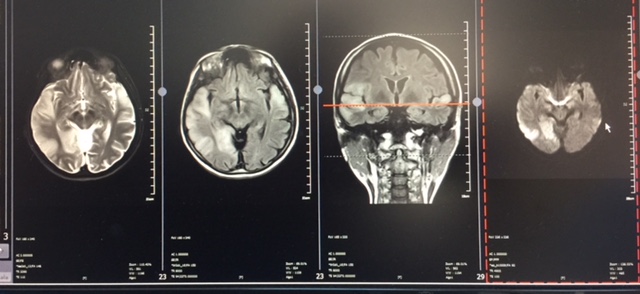Session Information
Date: Wednesday, September 25, 2019
Session Title: Phenomenology and Clinical Assessment of Movement Disorders
Session Time: 1:15pm-2:45pm
Location: Les Muses Terrace, Level 3
Objective: Arm levitation in MELAS syndrome
Background: MELAS syndrome has broad manifestations including stroke-like episodes, dementia, epilepsy, lactic academia, myopathy, recurrent headaches, hearing impairment, diabetes and short stature. Less than 5% of the patients is over age of 30 years of age.On the other way, abnormal movements develop as residual complications in up to 4% of patients with strokes. Spontaneous arm levitation is a kind of movement control disorder and often presents as apart of alien hand syndrome due to parietal lobe involvement. The predominant movement in arm levitation is an involuntary elevation of arm without endorsing any foreignness of the arm.
Method: Case
Results: We present a 34-year-old female with an involuntary arm movement on her left side beginning suddenly after a throbbing severe headache episode. The most striking feature of the movement was elevation of her left arm spontaneously while taking the history and while walking. She did not express any foreignness to her arm and with her other hand she has corrected the posture of elevated arm occasionally. In her first neurologic examination was normal except the defined arm levitation on her left side. She had short stature but no hearing loss detected in the first examination. Following few days, a kind of regressive behavior type was developed. She had diabetes history for more than five years. Her EEG at that time was epilepti-form with moderate localization of the right hemisphere. Her blood gases demonstrated high lactate levels. There was no family history of young onset stroke or resistant epileptic syndromes. Her first cranial imaging studiesdemonstrated right parietal cortical ischemic lesion convenient with diffusion-weighted images. After 5 days when the clinical feature of behavioral abnormality developed, the second imaging studies demonstrated extensive involvement of parietal and occipital lobes. The clinical features together with laboratory and imaging data have defined MELAS syndrome.
Conclusion: Stroke- like episodes are one the cardinal features of MELAS syndrome and temporal, parietal and occipital lobes are mostly involved. Spontaneous arm levitation occurring due to parietal lobe involvement was the presenting sign in this 34 year-old female patient. The present case was remarkable since arm levitation is not reported as an initial finding in MELAS patients but also adult MELAS patients are rare in the literature.
References: IrmadyK,JabbariB,LouisED.Armposturinginapatientfollowingstroke:dystonia,levitation,synkinesis,orspasticity?TremorOtherHyperkinetMov.2015; 5. A.W. El-Hattab et al. / Molecular Genetics and Metabolism 116 (2015) 4–12
To cite this abstract in AMA style:
D. Gunal, I. Midi, E. Erdil. Arm levitation as an early manifestation in MELAS syndrome: A case report [abstract]. Mov Disord. 2019; 34 (suppl 2). https://www.mdsabstracts.org/abstract/arm-levitation-as-an-early-manifestation-in-melas-syndrome-a-case-report/. Accessed April 17, 2025.« Back to 2019 International Congress
MDS Abstracts - https://www.mdsabstracts.org/abstract/arm-levitation-as-an-early-manifestation-in-melas-syndrome-a-case-report/

